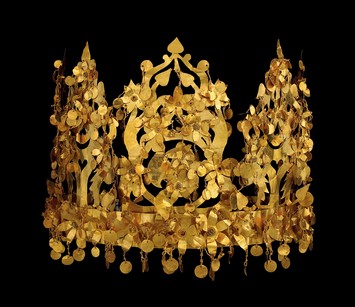 As this is being written, New Yorkers and out of town visitors are taking in,Afghanistan: Hidden Treasures from the National Museum, Kabul, now on display at the Met.
As this is being written, New Yorkers and out of town visitors are taking in,Afghanistan: Hidden Treasures from the National Museum, Kabul, now on display at the Met.
As Heritage Keys Helen Atkinson writes,the exhibit isa real treat.
But, while youre looking at the artefacts, heres an ancient mystery you may want to consider.
The crown on the top is on display at the show. As the caption notes its from Afghanistan and dates from the 1st century AD. Now, take a look at the second photo. This crown dates from between the 3rd and 5th centuries AD but was found in South Korea, nearly 5,000 kilometres away. It was used by a queen of Old Silla, one of the kingdoms in the area.
The similarity is pretty obvious.
In an interview (soon to be published) with Heritage Key, Professor Sarah Milledge Nelson, the archaeologist who literally wrote the book on Korean archaeology, says that, its more than a co-incidence. She recalled when the Afghanistan crowns were being uncovered decades back.
 When a site in Afghanistan, from the first and second centuries BC, was excavated everyone in Korea got really excited because the crown looked a lot like the shaman crown of Korea, she told me.
When a site in Afghanistan, from the first and second centuries BC, was excavated everyone in Korea got really excited because the crown looked a lot like the shaman crown of Korea, she told me.
(It was) made with gold, with little dangling things with little trees on it and so forth. Not identical but they had little things dangling down around the face to.
So what did Afghanistan and South Korea have in common nearly 2,000 years ago? The answer appears to be shamanism – the practice by which a person communicates with the spirits using rituals and various methods.
The practice can be found in antiquity throughout East and Central Asia. Crowns, similar to these two, have also been found in Siberia, where shamanism has been practiced up until recent times.
Professor Nelsonbelieves that the practice made its way into the ruling class in Silla, embedding itselfin its legends.
“The queens are descended from mountain goddesses and mountains are shamanic and still are as far as we know always were,” she said.
“So the mountain goddess was presumably a shaman and her daughters therefore inherited this ability to be shamans.”
It stands to reason that shamanism played some sort of role in Afghanistan rulership too.
Just as dragons transcend China and Western Europe, these shaman crowns appear to have transcended Asia – a little extra something to consider when attending the exhibition at the Met.